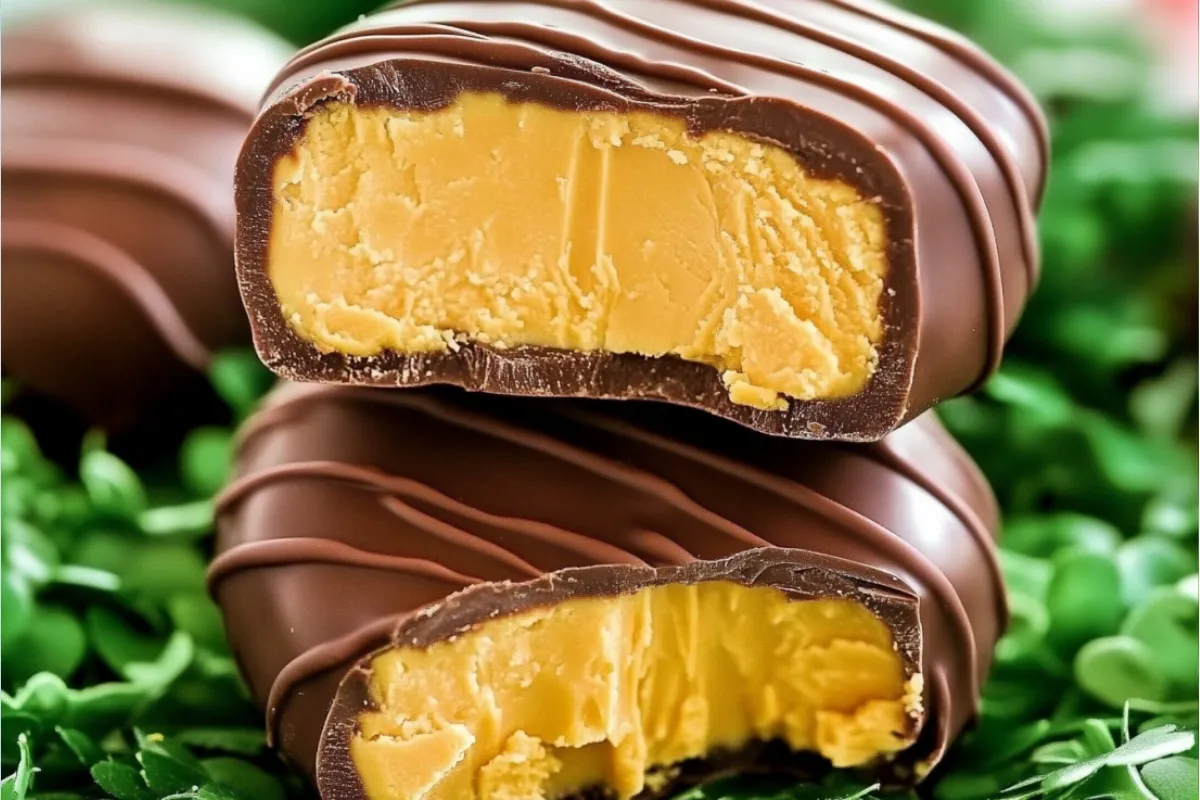Peanut Butter Eggs are a beloved treat, especially around holidays like Easter. There’s something so satisfying about that perfect combination of creamy peanut butter filling and smooth chocolate. I have fond memories of making Peanut Butter Eggs with my mom and grandma growing up, and now it’s a tradition I share with my own kids. We love getting creative with different shapes and decorations! This recipe is a simple, homemade version of that classic candy, perfect for making together as a family.
Why these Peanut Butter Eggs are special
These homemade Peanut Butter Eggs are truly special because you control the ingredients. You can adjust the sweetness of the peanut butter filling and choose your favorite type of chocolate for dipping. For other delicious chocolate treats, try these Chocolate Covered Strawberries. Plus, there’s nothing quite like the taste of freshly made treats using real, quality ingredients.
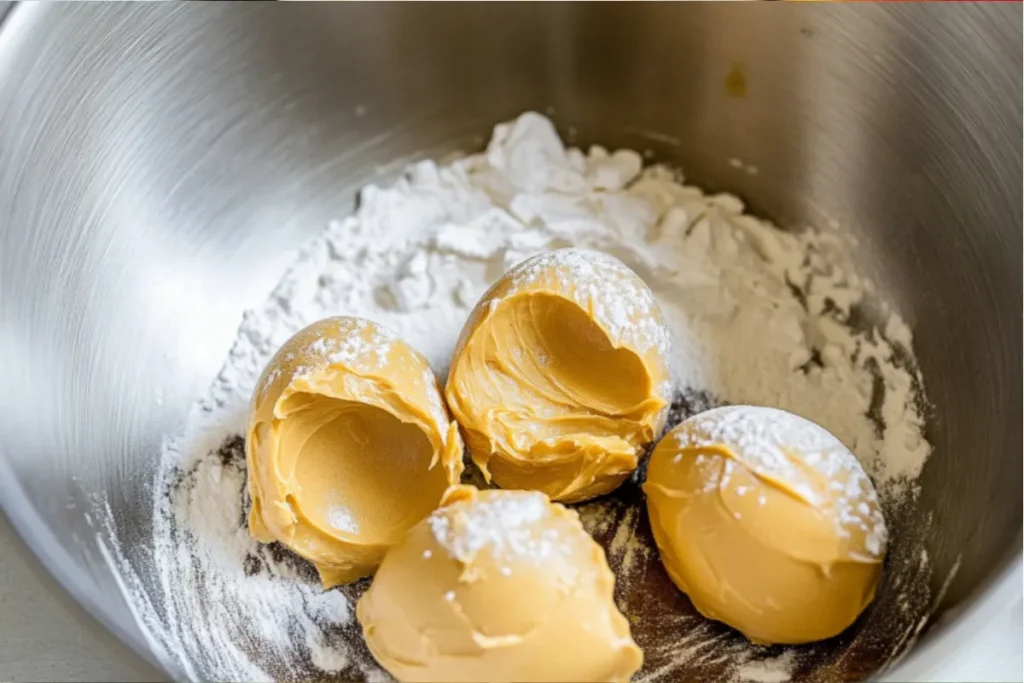
Ingredients
- 1 cup creamy peanut butter: Smooth peanut butter works best for a creamy filling.
- 1/2 cup powdered sugar: This sweetens the filling and helps it hold its shape.
- 1/4 cup unsalted butter, softened: Adds richness and helps bind the filling.
- 1/2 teaspoon vanilla extract: Enhances the flavor of the peanut butter.
- 16 ounces semi-sweet chocolate: This type of chocolate melts smoothly and has a good balance of sweetness.
Ingredient Substitutions
- For vegan Peanut Butter Eggs: Use vegan butter and ensure your chocolate is dairy-free.
- For sugar-free Peanut Butter Eggs: Substitute the powdered sugar with a sugar-free alternative, and use sugar-free chocolate. Keep in mind the texture might be slightly different.
Equipment Needed
- Mixing bowls: One for the peanut butter filling and one for melting the chocolate.
- Electric mixer (handheld or stand mixer): Makes mixing the filling easier.
- Measuring cups and spoons: Accurate measurements are key for a perfect recipe.
- Double boiler or microwave-safe bowl: For melting the chocolate gently and evenly.
- Parchment paper: To place the dipped eggs on while they set.
- Fork or dipping tools (optional): Helps with dipping and coating the eggs in chocolate.
How to Make Peanut Butter Eggs
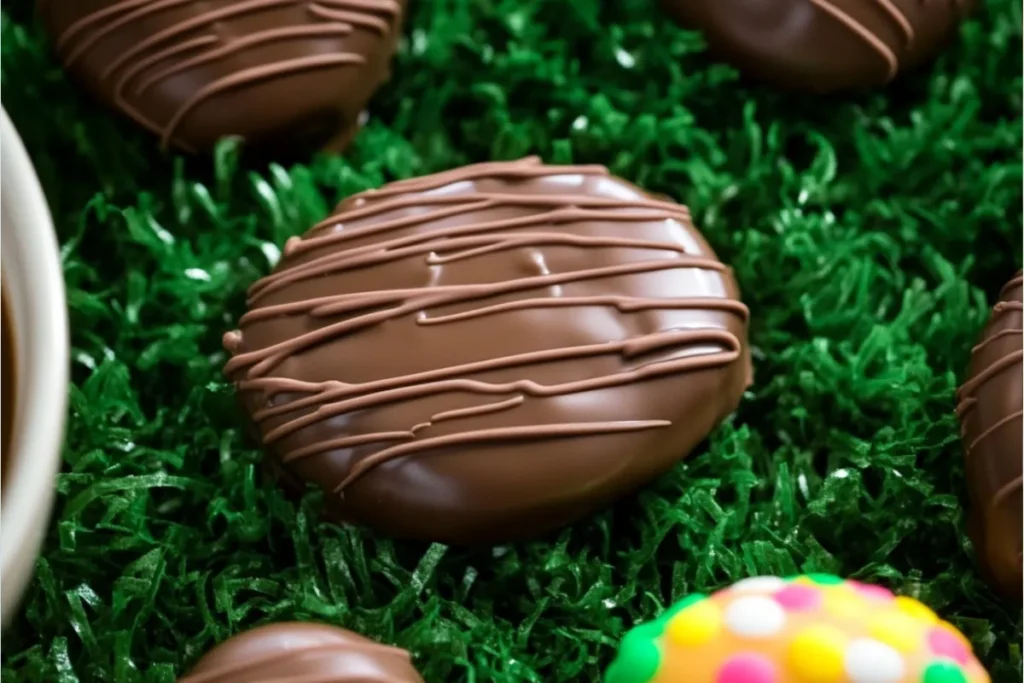
Making Peanut Butter Eggs is a fun and rewarding process. Just follow these easy steps, and you’ll have delicious homemade treats in no time! Looking for a fun breakfast treat? Check out these Fluffy Lemon Ricotta Pancakes.
Making the Peanut Butter Filling
- In a mixing bowl, combine the softened butter and peanut butter. Cream them together using an electric mixer until smooth and well combined. This usually takes about 1-2 minutes.
- Gradually add the powdered sugar, mixing on low speed to prevent it from flying everywhere. Once incorporated, increase the speed to medium and beat until the mixture is light and fluffy. This should take another 2-3 minutes.
- Stir in the vanilla extract until evenly distributed. The peanut butter mixture should be thick and moldable.
- Shape the peanut butter filling into egg shapes. You can do this by hand, rolling approximately 1 tablespoon of the mixture between your palms. Alternatively, you can use an egg-shaped mold for more uniform eggs.
- Place the shaped peanut butter eggs on a baking sheet lined with parchment paper. Place them in the freezer for at least 30 minutes to firm up before dipping in chocolate. This will make them easier to handle and prevent them from melting in the warm chocolate.
Melting and Tempering the Chocolate
- Chop the chocolate into small pieces to help it melt evenly. This is especially important if you’re using a microwave.
- Double Boiler Method: Fill the bottom pot of a double boiler with a few inches of simmering water. Place the chocolate in the top pot, ensuring it doesn’t touch the water. Stir occasionally until melted and smooth.
- Microwave Method: Place the chopped chocolate in a microwave-safe bowl. Microwave in 30-second intervals, stirring after each, until melted. Avoid overheating the chocolate, as it can seize up.
- Tempering (Optional but Recommended): Tempering chocolate gives it a professional sheen and prevents it from blooming (those white streaks that can appear). After melting, let the chocolate cool slightly. Then, seed it with a small amount of unmelted, finely chopped chocolate, stirring constantly until the temperature drops. This helps create stable crystals in the chocolate. For more information on the benefits of chocolate, check out this article from Healthline.
Dipping and Decorating the Eggs
- Remove the chilled peanut butter eggs from the freezer.
- Using a fork or dipping tools, carefully dip each egg into the melted chocolate, ensuring it’s fully coated.
- Lift the egg out of the chocolate, allowing any excess to drip back into the bowl. Gently tap the fork against the side of the bowl to remove any remaining drips.
- Place the dipped eggs back on the parchment-lined baking sheet.
- Decorate the eggs before the chocolate sets. You can drizzle a different type of melted chocolate over them, add sprinkles, or use a toothpick to create designs.
- Let the chocolate-covered eggs set completely at room temperature or in the refrigerator. Once set, they are ready to be enjoyed!
Tips and Variations
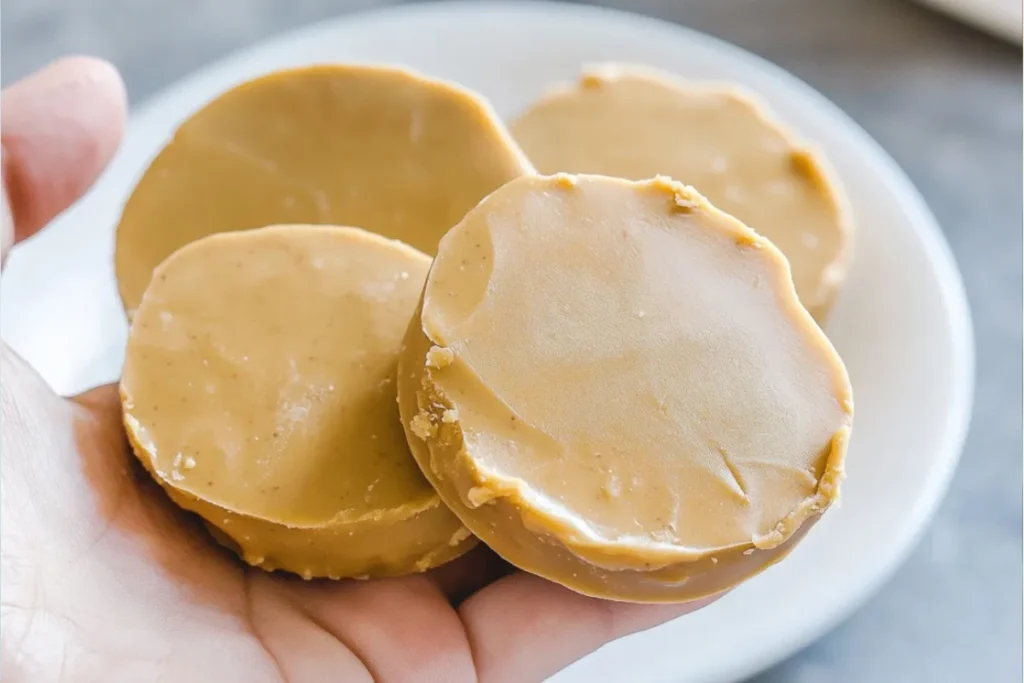
Making Peanut Butter Eggs is pretty straightforward, but here are a few tips and variations to help you achieve perfect results and get creative! If you’re looking for other sweet treats, give these 7-Minute Frosting a try.
Shaping the Eggs
- Traditional Method: Roll the peanut butter mixture between your palms to form egg shapes. Don’t worry if they aren’t perfectly uniform – homemade treats have their own charm!
- Using Molds: Silicone candy molds or even plastic Easter egg molds can create perfectly shaped eggs. Press the peanut butter filling firmly into the molds, then chill before dipping in chocolate.
- Mini Eggs: For bite-sized treats, roll the peanut butter mixture into small balls instead of egg shapes.
Flavor Variations
- Crunchy Eggs: Mix in chopped pretzels, rice cereal, or even crushed potato chips for added texture. My kids love the added crunch!
- Flavor Extracts: Experiment with different extracts like almond, peppermint, or maple to enhance the peanut butter flavor.
- Sweet and Salty: Mix in a pinch of sea salt to the peanut butter filling for a sweet and salty combination.
Chocolate Coating Options
- Milk Chocolate: Use milk chocolate for a sweeter coating. This is a classic choice that’s always a hit. If you enjoy baking with milk chocolate, you might also like these Cosmic Brownies.
- Dark Chocolate: Dark chocolate provides a richer, more intense flavor. It pairs beautifully with the peanut butter. To learn more about the health benefits of dark chocolate, take a look at this informative article from Healthline.
- White Chocolate: White chocolate creates a beautiful contrast and offers a different flavor profile. You can even tint white chocolate with food coloring for a festive touch. Get creative with your decorations! Drizzling a contrasting chocolate over the set eggs or adding sprinkles makes them even more special.
FAQ
What chocolate is best for peanut butter eggs?
Semi-sweet or milk chocolate is typically best for peanut butter eggs because they melt smoothly and have a good flavor balance. Look for chocolate specifically designed for melting or dipping, like Ghirardelli or Baker’s. These chocolates contain a higher percentage of cocoa butter, which gives them a better texture when set.
Why do Reese’s peanut butter eggs taste different?
Commercially produced peanut butter eggs like Reese’s often use different ingredients and processes than homemade versions. They may contain stabilizers, preservatives, and other additives that affect the flavor and texture. The ratio of peanut butter to chocolate might also be different. Homemade versions allow for fresh ingredients and customization.
Can I add peanut butter to scrambled eggs?
While it might sound unusual, peanut butter can actually add a creamy, nutty flavor to scrambled eggs! Try whisking a tablespoon of peanut butter into your eggs before cooking them. You can also add a dash of soy sauce for a savory twist. For some other great egg recipes, check out this collection.
Can peanut butter replace eggs in baking?
Peanut butter acts as a binder and adds fat to baked goods. It can sometimes replace eggs in recipes like cookies or brownies, creating a denser, chewier texture. However, it’s not recommended to replace eggs in this peanut butter egg recipe, as the eggs are crucial for binding the filling and creating the right consistency.
Storing and Serving Your Peanut Butter Eggs
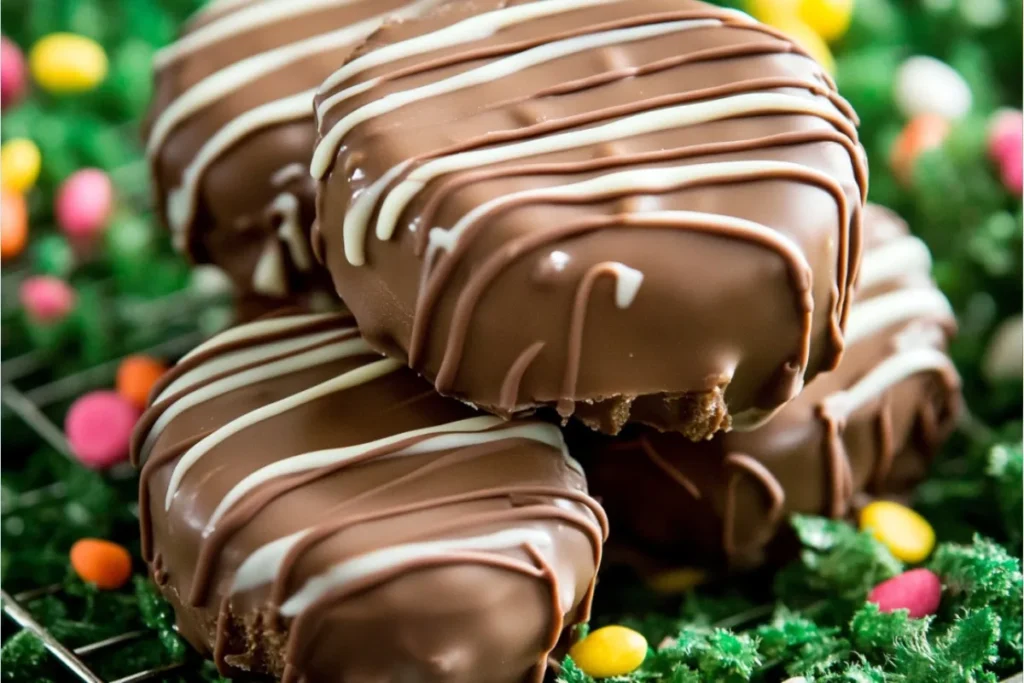
Here’s how to store your delicious homemade Peanut Butter Eggs to keep them fresh and prevent that dreaded chocolate bloom.
Serving Suggestions
Peanut Butter Eggs are perfect for so many occasions! They make delightful treats for Easter baskets, birthday parties, or any holiday gathering. They’re a fun dessert after dinner or a sweet snack any time of day. You can even package them beautifully in small boxes or bags and give them as gifts to friends and family. If you enjoy peanut butter treats, you might also like these cereal bars.
Storage Tips
- Room Temperature: If you used milk or dark chocolate, you can store the Peanut Butter Eggs in an airtight container at room temperature for up to a week. Avoid storing them in direct sunlight or warm areas.
- Refrigeration: If you live in a warmer climate or used white chocolate, which is more sensitive to temperature changes, it’s best to store the eggs in the refrigerator. Place them in an airtight container to prevent them from absorbing odors. Chilling them also gives them a nice, firm bite.
- Preventing Bloom: To minimize chocolate bloom (those whitish streaks), ensure the chocolate is tempered properly. Store the eggs in a cool, dry place away from humidity and temperature fluctuations.
Conclusion
I hope you enjoy making these homemade Peanut Butter Eggs! They’re a fun and rewarding project, especially when enjoyed with loved ones. Feel free to get creative with the shapes, decorations, and flavor combinations. There’s no limit to the delicious possibilities! Sharing homemade treats is a special way to show you care, and these Peanut Butter Eggs are sure to bring smiles to everyone’s faces. Happy cooking!
PrintPeanut Butter Eggs
- Yield: Estimate: 20-24 eggs depending on size
Description
- A simple, homemade version of classic Peanut Butter Eggs. Creamy peanut butter filling dipped in smooth, rich chocolate. Perfect for Easter or any occasion!
Ingredients
- 1 cup creamy peanut butter
- 1/2 cup powdered sugar
- 1/4 cup unsalted butter, softened
- 1/2 teaspoon vanilla extract
- 16 ounces semi-sweet chocolate
Instructions
1. Make the Peanut Butter Filling: Cream together butter and peanut butter. Gradually add powdered sugar and beat until fluffy. Mix in vanilla.
2. Shape the Eggs: Roll the peanut butter mixture into egg shapes and freeze for 30 minutes.
3. Melt & Temper Chocolate: Melt chocolate in a double boiler or microwave. Temper for a smooth finish (optional).
4. Dip & Decorate: Dip frozen peanut butter eggs into melted chocolate. Decorate with sprinkles or drizzled chocolate. Let set.
Notes
For vegan eggs, use vegan butter and dairy-free chocolate. For sugar-free eggs, use sugar-free alternatives. Get creative with different extracts, mix-ins, and chocolate coatings. See tips and variations in the article for more details.
- Category: Dessert
- Cuisine: American
Nutrition
- Serving Size: 1 peanut butter egg
Keywords: Peanut Butter Eggs, peanut butter candies, chocolate-covered peanut butter, homemade Easter treats, peanut butter and chocolate treats, Easter candy, no-bake dessert, easy recipe, kid-friendly recipe

